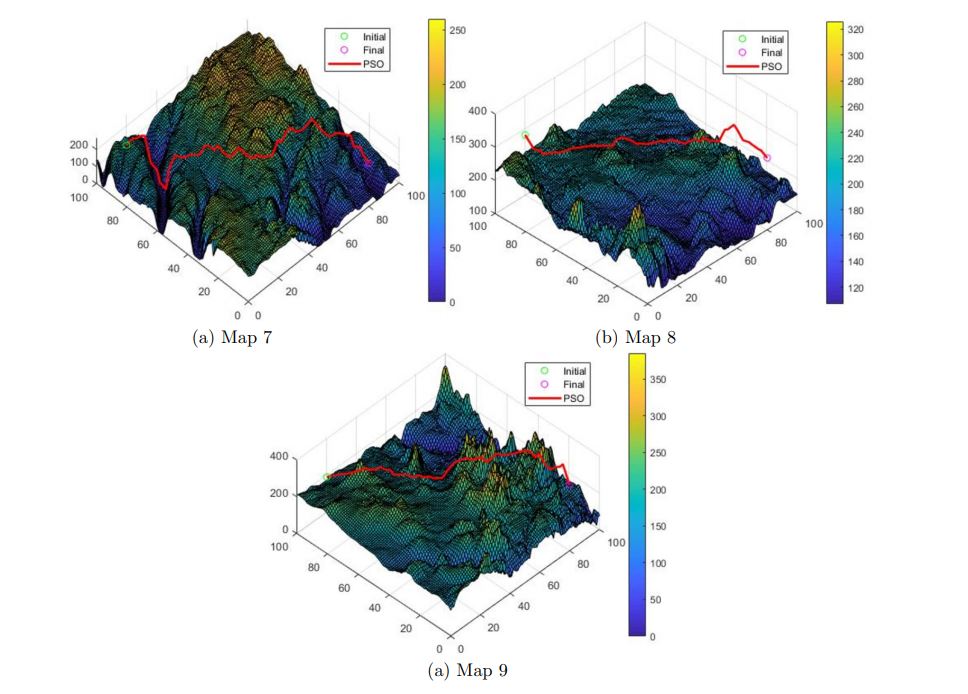Enhanced Particle Swarm Optimization for Path Planning of Unmanned Aerial Vehicles
Main Article Content
Abstract
This paper presents an enhanced particle swarm optimization (PSO) for the path planning of unmanned aerial vehicles (UAVs). An evolutionary algorithm such as PSO is costly because every application requires different parameter settings to maximize the performance of the analyzed parameters. People generally use the trial-and-error method or refer to the recommended setting from general problems. The former is time consuming, while the latter is usually not the optimum setting for various specific applications. Hence, this study focuses on analyzing the impact of input parameters on the PSO performance in UAV path planning using various complex terrain maps with adequate repetitions to solve the tuning issue. Results show that inertial weight parameter is insignificant, and a 1.4 acceleration coefficient is optimum for UAV path planning. In addition, the population size between 40 and 60 seems to be the optimum setting based on the case studies.
Article Details

This work is licensed under a Creative Commons Attribution-NonCommercial-NoDerivatives 4.0 International License.
References
K.K. Yit, P. Rajendran, Enhanced Longitudinal Motion Control of UAV Simulation by Using P-LQR Method, Int J Micro Air Veh, 7 (2015) 203-210.
F. Shahzad, S. Masood, N.K. Khan, Probabilistic opposition-based particle swarm optimization with velocity clamping, Knowledge and information systems, 39 (2014) 703-737.
H. Eisenbeiss, A mini unmanned aerial vehicle (UAV): system overview and image acquisition, International Archives of Photogrammetry. Remote Sensing and Spatial Information Sciences, 36 (2004) 1-7.
W. Zhu, H. Duan, Chaotic predator-prey biogeography-based optimization approach for UCAV path planning, Aerospace science and technology, 32 (2014) 153-161.
H. Duan, L. Huang, Imperialist competitive algorithm optimized artificial neural networks for UCAV global path planning, Neurocomputing, 125 (2014) 166-171.
A.M. Khaleghi, D. Xu, Z. Wang, M. Li, A. Lobos, J. Liu, Y.-J. Son, A DDDAMS-based planning and control framework for surveillance and crowd control via UAVs and UGVs, Expert Systems with Applications, 40 (2013) 7168-7183.
T. Cabreira, L. Brisolara, P. R Ferreira, Survey on Coverage Path Planning with Unmanned Aerial Vehicles, Drones, 3 (2019) 4.
A. Tharwat, M. Elhoseny, A.E. Hassanien, T. Gabel, A. Kumar, Intelligent Bézier curve-based path planning model using Chaotic Particle Swarm Optimization algorithm, Cluster Computing, (2018) 1-22.
S.K. Debnath, R. Omar, N.B.A. Latip, A Review on Energy Efficient Path Planning Algorithms for Unmanned Air Vehicles, in: Computational Science and Technology, Springer, 2019, pp. 523-532.
J. Kennedy, R. Eberhart, Particle swarm optimization (PSO), in: Proc. IEEE International Conference on Neural Networks, Perth, Australia, 1995, pp. 1942-1948.
Y. Shi, R. Eberhart, A modified particle swarm optimizer, in: Evolutionary Computation Proceedings, 1998. IEEE World Congress on Computational Intelligence., The 1998 IEEE International Conference on, IEEE, 1998, pp. 69-73.
Z.-L. Gaing, Particle swarm optimization to solving the economic dispatch considering the generator constraints, IEEE transactions on power systems, 18 (2003) 1187-1195.
Y. Shi, R.C. Eberhart, Empirical study of particle swarm optimization, in: Evolutionary Computation, 1999. CEC 99. Proceedings of the 1999 Congress on, IEEE, 1999, pp. 1945-1950.
R. Eberhart, Y. Shi, Comparison between genetic algorithms and particle swarm optimization, in: Evolutionary programming VII, Springer, 1998, pp. 611-616.
P.J. Angeline, Using selection to improve particle swarm optimization, in: Evolutionary Computation Proceedings, 1998. IEEE World Congress on Computational Intelligence., The 1998 IEEE International Conference on, IEEE, 1998, pp. 84-89.
Y. Shi, R. Eberhart, Parameter selection in particle swarm optimization, in: Evolutionary programming VII, Springer, 1998, pp. 591-600.
I.C. Trelea, The particle swarm optimization algorithm: convergence analysis and parameter selection, Information processing letters, 85 (2003) 317-325.
M. Jiang, Y.P. Luo, S.Y. Yang, Stochastic convergence analysis and parameter selection of the standard particle swarm optimization algorithm, Information processing letters, 102 (2007) 8-16.
V. Roberge, M. Tarbouchi, G. Labonté, Comparison of parallel genetic algorithm and particle swarm optimization for real-time UAV path planning, IEEE Transactions on Industrial Informatics, 9 (2013) 132-141.
Y. Fu, M. Ding, C. Zhou, Phase angle-encoded and quantum-behaved particle swarm optimization applied to three-dimensional route planning for UAV, IEEE Transactions on Systems, Man, and Cybernetics-Part A: Systems and Humans, 42 (2012) 511-526.
E. Besada-Portas, L. De La Torre, A. Moreno, J.L. Risco-Martín, On the performance comparison of multi-objective evolutionary UAV path planners, Information Sciences, 238 (2013) 111-125.
K.Y. Kok, P. Rajendran, Differential-Evolution Control Parameter Optimization for Unmanned Aerial Vehicle Path Planning, Plos One, 11 (2016).
F. Van Den Bergh, A.P. Engelbrecht, A study of particle swarm optimization particle trajectories, Information Sciences, 176 (2006) 937-971.
R.C. Eberhart, Y. Shi, Comparing inertia weights and constriction factors in particle swarm optimization, in: Evolutionary Computation, 2000. Proceedings of the 2000 Congress on, IEEE, 2000, pp. 84-88.


